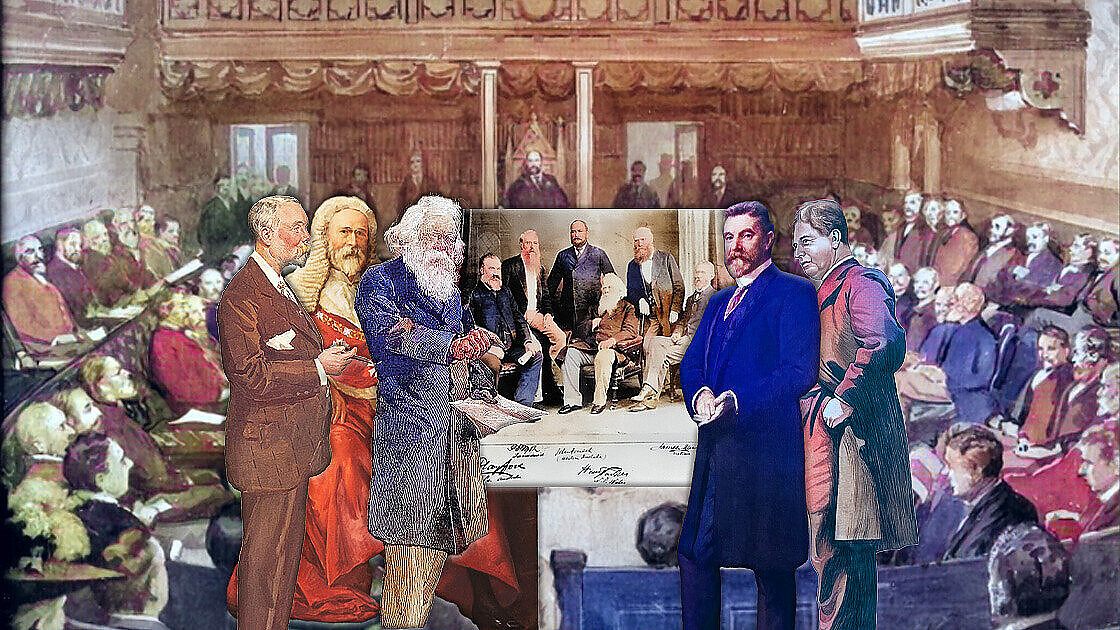From Federation
The Federation of Australia was a Unique Achievement:
- Although the British had first proposed it decades before, it was actually drafted in Australia by Australians and approved by the Australian people in each of the colonies states.
- The British allowed Australians to change their Constitution without reference to London.
- The Governor-General was Granted by a constitutional provision the direct exercise of the executive power of the Commonwealth.
- It was Peaceful.
Federation was thus the sixth pillar of the nation.
Australia has been able to enjoy a peaceful, limited government, both in times of peace and war, as well as during times of prosperity and depression, thanks to the Federal Constitution. This document has allowed the nation to transition from being a self-governing Dominion within the British Empire to achieving full independence as a Realm within the Commonwealth. The Federation was established on the principle of the new entity being an indissoluble Federal Commonwealth under the Crown, which remains a fundamental aspect of the nation’s federal structure. While there have always been individuals who sought to remove the Crown, these individuals were not elected to the nineteenth-century conventions.
For almost all of the first century of the federation, no Australian leader had questioned the place of the Crown in our constitutional system.

In 1993, the Australian government, led by Prime Minister Paul Keating, initiated efforts to explore the potential for Australia to transition to a republic. A Republic Advisory Committee, helmed and chaired by Malcolm Turnbull, was established to conduct the necessary research.
The committee mandated that all appointees must demonstrate a prior commitment to removing the Australian Crown, regardless of any advice sought from the Premiers regarding appointments.
This report presents insightful research regarding Republican models. Back in 1995, the prime minister expressed the government’s intention to pursue a proposal to modify the Constitution by eliminating the monarchy. Under the new system, the president would be selected through an election and can be removed through a two-thirds majority vote during a joint session of the Senate and House of Representatives.
The proposal did not move forward due to the defeat of the Keating government in the 1996 election.
In 1997, in pursuit of an election promise, the Howard government called an election for half of the places to the Constitutional Convention, which met in 1998.
The remaining members were appointed and were mainly ex officio. By their voting at the Convention, it was clear that a majority of the appointed members favoured removing the Crown.
Although the Convention voted for change, the model preferred by the overwhelming majority of Republican delegates could not command a majority vote. To the approval of the Republican movement and most of the mainline media who were campaigning for change, the Prime Minister ruled that this would be the subject of a referendum.
In 1999, a referendum was called in which the people were invited to vote on this republican model. This was the referendum model, which had the overwhelming support of the Republican delegates to the Constitutional Convention. Most of the mainline media and most of the sitting politicians campaigned in its favour.
The referendum was defeated nationally (55:45), in all states and 72% of electorates. After the defeat, the ARM and the Labor Party called for a national plebiscite to be held in which people would be asked whether they wanted Australia to become a republic. No details would be revealed.
If this were passed, another plebiscite would follow in choosing between different forms of republics. The existing constitution would be excluded from that vote. After the second plebiscite, a referendum on the preferred Republican model would follow. After this, a conference was held at Corowa, which endorsed this plan.
A Senate Inquiry was established in 2003, which produced a report just before the 2004 election, Road to a Republic. This endorsed the ARM-ALP proposal for two plebiscites, but Liberal Senator Marise Payne, an ARM office bearer, dissented from the proposal for two plebiscites.
Then came a Republican “Mate for a Head of State” campaign, which failed to create any support for a renewed campaign, and then the 2020 Summit, whose governance panel, after minimal discussion, voted an improbable 98:1 in favour of Australia becoming some vague, undefined republic.
Shortly after the Summit, the Morgan Poll reported the lowest support for a republic in 15 years, with very low support among the young.




